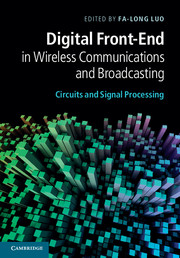Book contents
- Frontmatter
- Contents
- Contributors
- Preface
- Part I Introduction to digital front-end
- Part II DPD and CFR
- Part III DUC, DDC, ADC, DAC, and NCO
- Part IV Digital calibration, imbalance compensation, and error corrections
- 16 Digital compensation and calibration of I/Q gain and phase imbalances
- 17 Joint digital predistortion of I/Q modulator and power amplifier impairments
- 18 Diversity and error compensation in OFDM transceivers
- 19 Front-end architectures and impairment corrections in multimode and multi-antenna systems
- Part V Circuits and system integration in digital front-end
- Index
- References
17 - Joint digital predistortion of I/Q modulator and power amplifier impairments
from Part IV - Digital calibration, imbalance compensation, and error corrections
Published online by Cambridge University Press: 07 October 2011
- Frontmatter
- Contents
- Contributors
- Preface
- Part I Introduction to digital front-end
- Part II DPD and CFR
- Part III DUC, DDC, ADC, DAC, and NCO
- Part IV Digital calibration, imbalance compensation, and error corrections
- 16 Digital compensation and calibration of I/Q gain and phase imbalances
- 17 Joint digital predistortion of I/Q modulator and power amplifier impairments
- 18 Diversity and error compensation in OFDM transceivers
- 19 Front-end architectures and impairment corrections in multimode and multi-antenna systems
- Part V Circuits and system integration in digital front-end
- Index
- References
Summary
Introduction
The analog front-end of a direct-conversion transmitter suffers from several performance-degrading circuit implementation impairments. The main impairments are power amplifier (PA) nonlinear distortion, in-phase/quadrature-phase (I/Q) imbalance, and local oscillator (LO) leakage. Each of these impairments has been treated separately in the literature as well as on the pages of this book. For details on state-of-the-art PA predistortion, the reader is referred to the related chapters in Part II of this book and the references therein, and for a comprehensive review on I/Q imbalance compensation, to Chapter 16 of this book and the literature cited therein. It has been demonstrated that, when treated separately, each of the impairments can be mitigated by using digital predistortion. What is often overlooked, however, is that in direct-conversion transmitters these impairments interact in a manner that may severely cripple the overall transmitted signal quality. In addition to the obvious effects of I/Q imbalance and LO leakage (mirror-frequency interference (MFI) and spurious signal energy at the LO frequency, respectively), there are several other performance-degrading phenomena arising from their interaction with the nonlinearity that need addressing. First, I/Q imbalance and LO leakage cause extra intermodulation distortion (IMD) products to appear at the PA output [6], [9]. Effectively this means that even with access to ideal PA predistorter (PD) coefficients, spectral regrowth will not be fully mitigated. Second, the extra IMD products at the PA output will interfere with the estimation of an adaptive PA PD [6], [9]. In other words, if the PA PD is trained with no regard for I/Q imbalance and LO leakage, the resulting PD will be biased, and thus the overall transmitted signal quality will be further compromised. Third, PA nonlinearity interferes with the estimation of the I/Q modulator (IQM) predistorter, yielding biased estimates. This makes it difficult to compensate for IQM impairments prior to PA PD estimation. These aspects will be discussed in more detail in Section 17.2.
Information
- Type
- Chapter
- Information
- Digital Front-End in Wireless Communications and BroadcastingCircuits and Signal Processing, pp. 502 - 530Publisher: Cambridge University PressPrint publication year: 2011
